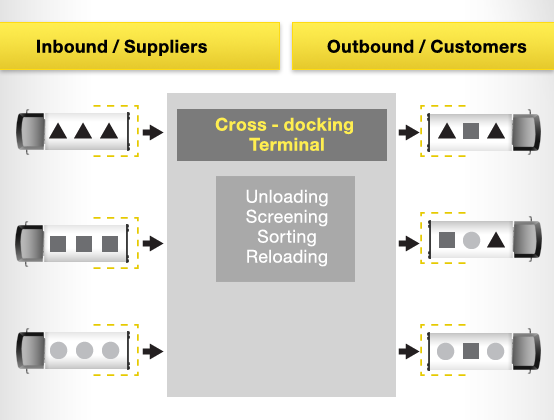What is Cross-docking - Understanding the concept & definition
Speed and productivity of a supply chain has become an important factor of growth for organisations. Cross-docking is just one strategy that can be implemented to help achieve a competitive advantage. Implemented appropriately and in the right conditions, cross-docking can provide significant improvements in efficiency and handling times.
What is cross docking?
Cross docking is a logistics procedure where products from a supplier or manufacturing plant are distributed directly to a customer or retail chain with marginal to no handling or storage time. Cross docking takes place in a distribution docking terminal; usually consisting of trucks and dock doors on two (inbound and outbound) sides with minimal storage space. The name ‘cross docking’ explains the process of receiving products through an inbound dock and then transferring them across the dock to the outbound transportation dock.

In simple terms, inbound products arrive through transportation such as trucks/trailers, and are allocated to a receiving dock on one side of the ‘cross dock’ terminal. Once the inbound transportation has been docked its products can be moved either directly or indirectly to the outbound destinations; they can be unloaded, sorted and screened to identify their end destinations. After being sorted, products are moved to the other end of the ‘cross dock’ terminal via a forklift, conveyor belt, pallet truck or another means of transportation to their destined outbound dock. When the outbound transportation has been loaded, the products can then make their way to customers.
When is cross-docking used?
The process of cross docking will not suit every warehouses needs, it is therefore important to make an informed decision as to whether cross-docking will increase the productivity, costs and customer satisfaction for your specific business. Cross docking can advance the supply chain for a variety of specific products. For one, unpreserved or temperature controlled items such as food which need to be transported as quickly as possible can be benefitted by this process. Additionally, already packaged and sorted products ready for transportation to a particular customer can become a faster and more efficient process through cross docking.
Some of the main reasons cross docking is implemented is to:
- Provide a central site for products to be sorted and similar products combined to be delivered to multiple destinations in the most productive and fastest method. This process can be described as “hub and spoke”
- Combine numerous smaller product loads into one method of transport to save on transportation costs. This process can be described as ‘consolidation arrangements’.
- Break down large product loads into smaller loads for transportation to create an easier delivery process to the customer. This process can be described as ‘deconsolidation arrangements’.
Hopefully this blog assists you in understanding the concept of cross-docking and why it is implemented into an organisations supply chain process. The next part to this blog will detail the advantages and disadvantages of cross-docking for a greater understanding of this process.